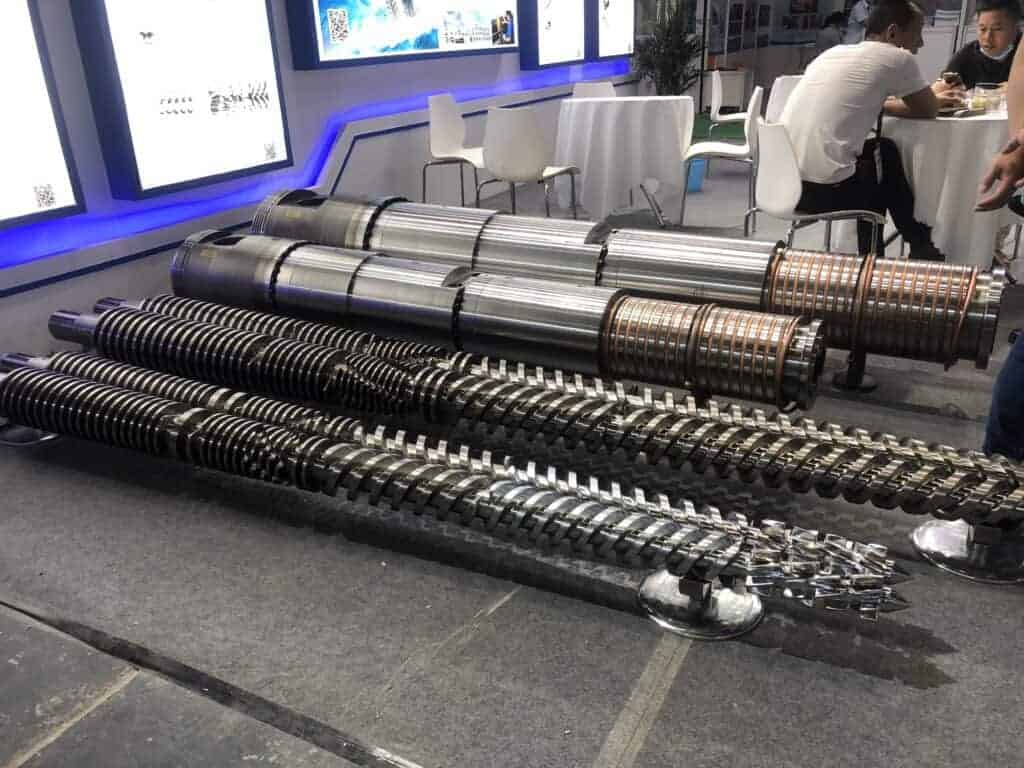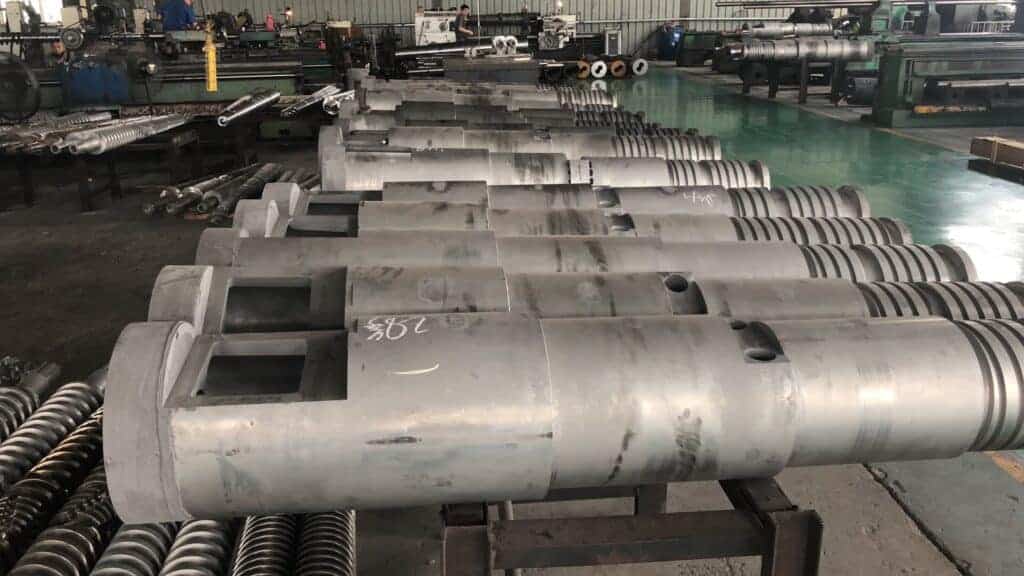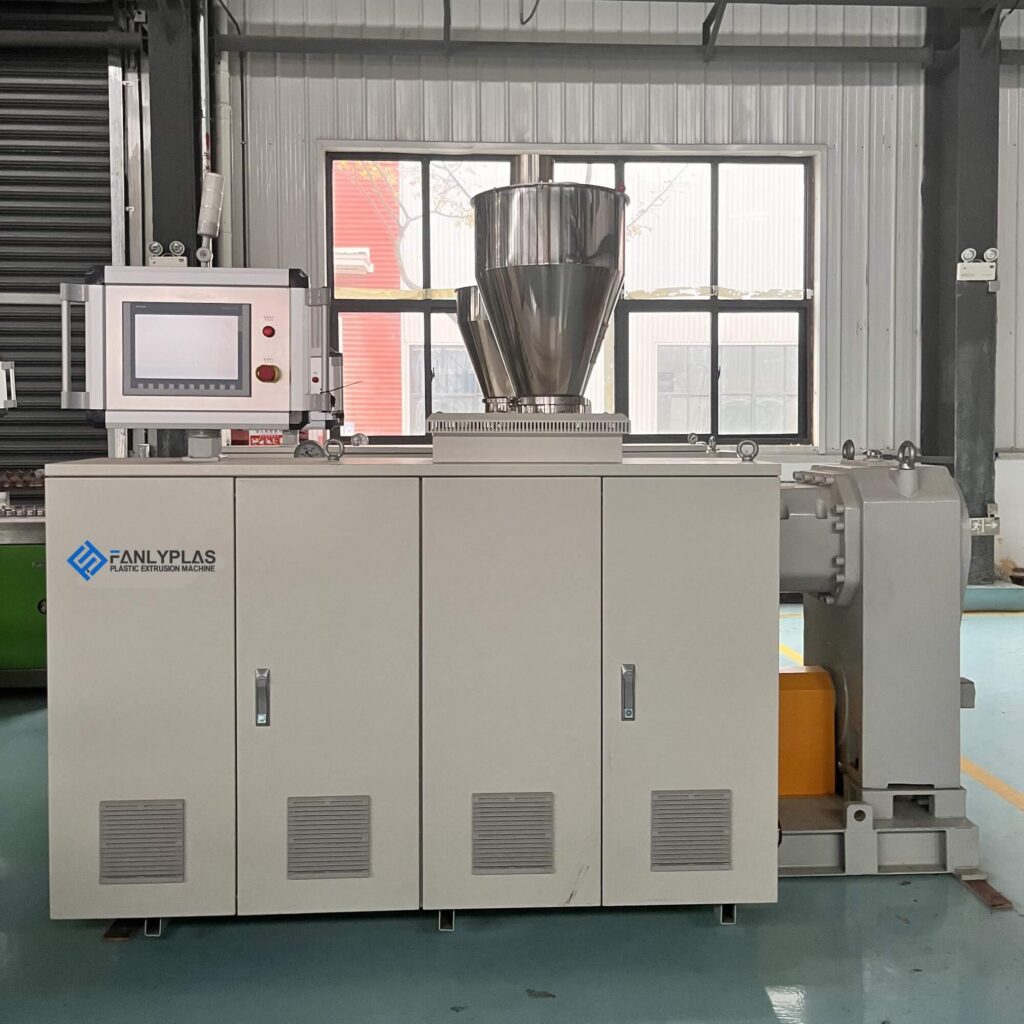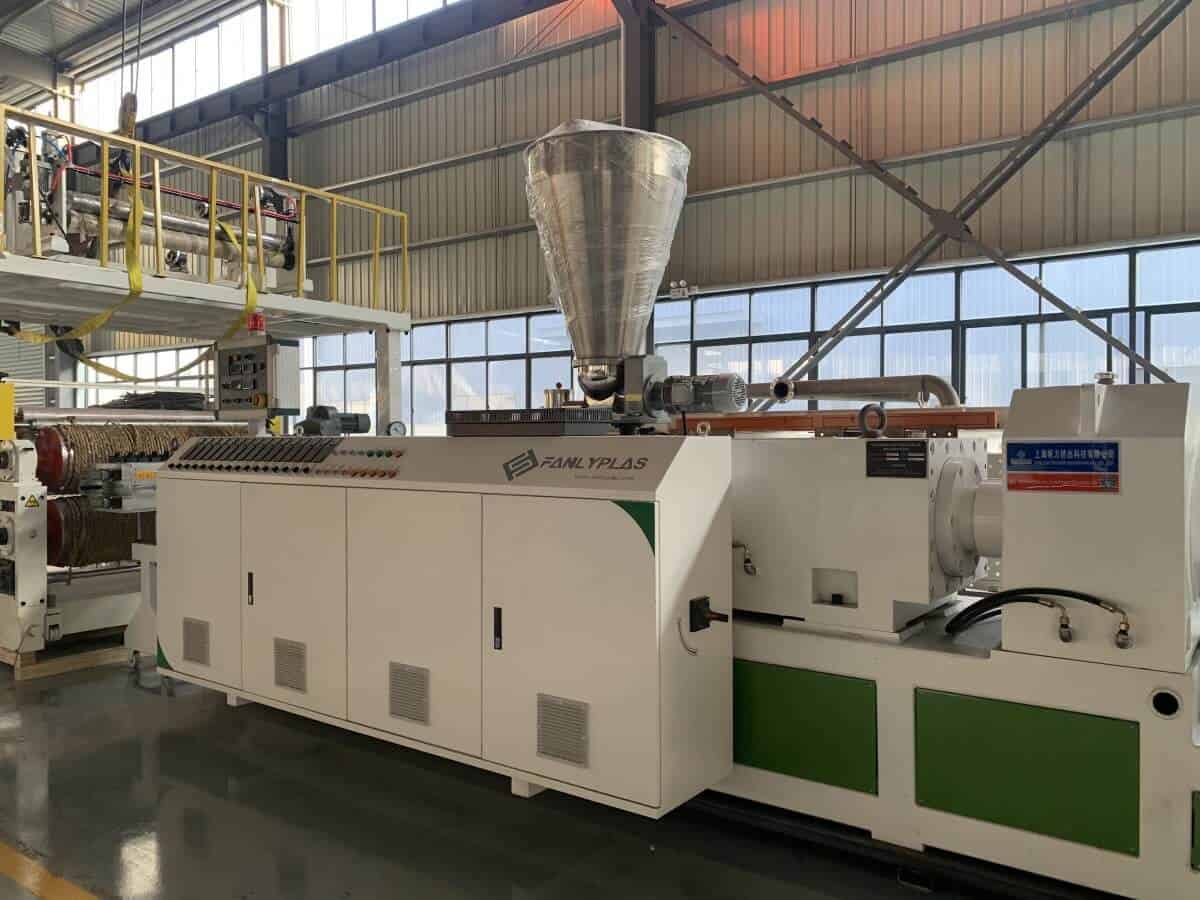Introduction
Twin-screw extruders are an integral part of plastic manufacturing equipment such as the PVC foam board extrusion line or the PVC WPC door frame production line. It is at the twin-screw extruder where material, in the form of PVC powder, is fed into the production line. The screw continuously rotates to facilitate the movement of the material through the barrel.
The twin-screw extruder is one of the most important components of the production line. There are several tactics that you can incorporate to boost its efficiency and optimize the production capacity. You can achieve that through altering operating specifications, proper equipment maintenance, or equipment modification. In this article, we focus on the types and effects of twin-screw degradation. We will also be highlighting solid measures to enhance the performance of the extruder in your PVC foam board extrusion machine.

Types of Extruder Screw Wear in Your PVC Foam Board Extrusion Line
The twin-screw extruder is where most high-pressure processing activities occur. Metal-to-metal friction causes screw wear too. It occurs when barrel ID and flight OD come into contact with one another. Here is an analysis of common functionality errors your extruder screw is likely to encounter and their possible solutions:
corrosive wear
The screw wear type comes about because of the use of additives as well as degraded polymer particles. Degraded polymer particles and additives contain chemical agents that attack the screw surface leading to deterioration. A huge chunk of corrosive wear takes place within the metering zone. It is a consequence of soaring temperatures within the zone.
Extreme temperatures in the area are linked to the long duration of materials spent within the metering zone. Spending a lot of time in the metering compartment increases the rate of product degradation. When materials like PVC degrade, they produce HCL, a highly corrosive acid that wears out the screw.
Solution
The best way to seek out corrosive wear is by utilizing surface treatments to neutralize corrosion.
Adhesive wear
Adhesive wear is a kind of screw surface deterioration linked to friction that occurs when the screw surface and the cylinder come into contact. It happens as a result of continuous rotation. As the screw moves around, it comes into slight contact with the extruder’s surface. As this continuously goes on, the surfaces on the inner barrel and outer screw start deteriorating. The effect of metal-to-metal contact between the two surfaces gets worse when there is a bend or misalignment between the two.
Solution
To mitigate this type of wear phenomenon, you will have to realign the screw and the barrel correctly. Similarly, you have to straighten any part that may be bent. Lubrication will also go a long way in curbing constant friction.
Abrasive wear
It is triggered by rigid particles like flame retardants, calcium carbonate, and glass fiber that are added into the extrusion machine alongside polymers. As the polymer with hard particles slides through the screw at high temperature and pressure it induces abrasion. The rigid pellets scratch, impact, and creep the surfaces of the extruder barrel and screw. Additionally, the intensity of the abrasion is anchored on the size and shape of the particles. Bigger or sharper pellets cause more damage.
Solution
Abrasive wear is a defect that can be rectified by choosing materials with fewer fillers or additives. In addition, the impact of the hard particles can be controlled by hardening the cylinder and screw surfaces.

Causes of Screw Wear
The twin-screw extruder of your PVC foam board-making machine or any other plastic equipment is prone to wear and tear over the course of its use. Knowing the source of wear can help you to maintain the component properly. It is also key in alleviating the after-effects of a deteriorated extruder:
You will be promoting screw wear by utilizing materials such as glass fiber and calcium carbonate in the extruder. Such materials are called fillers and they contain hard particles. Hard particles require increased heat to soften. It is their unforgiving interaction with the surface of the screw that amounts to abrasion and eventually wears it out. Unmelted pellets together with large unprocessed filter particles featuring sharp corners have a detrimental impact on the extruder screw.
1. Unstable processing temperature
If the extrusion temperature is too low, it arouses an increase in the working torque of the screw in the extruder. When the torque force becomes too much for the screw’s strength limit, it forces the screw to bend or twist. The working torque will also be affected if the raw materials are mixed with impurities. Impurities come in the form of foreign metal particles.
2. Repeated decomposition of extruded extracts
When extruded materials keep on decomposing, they will have a harmful outcome on the life of the screw. Frequent decomposition of PVC for instance leads to the production of a significant quantity of hydrochloric acid. HCL acid is known to be highly corrosive. It will affect not only the screw but also other parts of the extruder.
3. Inconsistent cylinder heating during PVC foam board making
When the barrel or screw is fed with materials containing hard particles like calcium carbonate, there is a need for increased heating to make the materials soft for efficient processing. When the extruder’s working surface fails to get sufficient heat treatment, it sparks heightened abrasive and adhesive wear.
4. Friction
Extrude material is processed by the rotation of the screw within the extruder barrel. Friction occurs because of metal-to-metal contact that happens between the rotation of the screw and the extruder cylinder barrel. The cylinder’s surface and the thread crest of the screw might slightly come into contact if there are not aligned properly.
For smooth running and mitigated wear of the screw, it is imperative to keep the cylinder and the screw as straight as possible. As the parts continue to wear, the diameter inside the barrel increases while the outer screw diameter decreases. When the gap between the barrel and the screw grows bigger, it generates incomplete plasticization of materials among other shortcomings.
5. Improper material selection
When you select the wrong kind of materials for the extruder barrel and extruder screw, you will be initiating irreversible wear. Materials with hard particles like flame retardants lead to abrasive wear. It is heightened by low temperatures. Choosing the wrong material type elicits a compromised working efficiency between the barrel and screw. In the end, it induces accelerated screw wear.
6. Improper operation of the PVC foam board extrusion line
Improper operation results in wrong heating values and the use of wrong materials. It also contributes to the utilization of excessive fillers and the setting of unstable processing temperatures. Basically, if you run the extrusion equipment without proper knowledge of how to do it, the end result is an increase in the wear of the screw and other vital parts.

Methods of improving the efficiency of your twin-screw extruder
Clean the extruder regularly
Rather than waiting for your extruder to shut down and eat into your precious production schedule, it is advisable to keep it clean at all times. Purging your extruder if you do not want to undertake stripdown cleaning. Stripdown cleaning can be time-consuming. There are numerous purging materials you can use to get rid of unwanted materials from the die and extruder components.
Purging materials fall into either mechanical abrasive purges or chemical purges. Mechanical-based purges scrub and scour foreign materials off metallic surfaces employing shear and friction. On the other hand, chemical purges will dissolve and attack any plastic residue lingering on the extruder’s surface.
Install thermal insulator gaskets
Most extruders face a common problem related to uniform heat distribution within the barrel leading to temperature inconsistencies. Ideally, the barrel is usually bolted in a flange to flange manner allowing heat to systematically move from the hot to cool ends of the barrel.
It is this design fault that causes heating problems. However, installing insulator gaskets in between the feed barrel and the flanges mitigates heat loss. The insulator gaskets tend to crumble and wear out with time. Thus, replace the insulator gaskets after a while.
Utilize anti-seize lubricants
Anti-seize lubricants play a big role in eliminating adhesive elements that might stick in the gap between spline shafts and screw elements. The high-strength adhesive forms when low-viscosity polymers creep down into the aforementioned gap. Nonetheless, anti-seize lubricants do not fit long-term usage as they tend to degrade quickly. Therefore, it is crucial to replace the lubricant regularly.
Opt for gear oil types that are synthetic
The gearbox is the center of the functionality of the twin-crew extruder. A problem within the gearbox is likely to lead to a very costly downtime along with expensive repair expenses. Utilizing ideal gear oil will curb wear and tear and eliminate the setback. Not just any other kind of gear oil but synthetic gear oil will yield the best results.
Synthetic gear oil provides added slipperiness which is effective in curbing friction. Additionally, it is long-lasting with durable viscosity even under extreme temperatures.
Adopt cooling bores with acid-flush capabilities
Water-cooled extruder barrels act like heat exchangers. Yet, typical heat exchangers are prone to scale build-up that causes fouling after several years of production. Scale build-up attacks the cooling bores, lining their surface with deposits of crusty minerals. The crusty lining forms some kind of insulation. Insulation at this point is problematic to the functionality of the extruder.
Apart from that, the crusty mineral buildup could fully block the bores cutting off water flow. To resolve the problem, you need cooling bores with acid-flush capabilities. The acid will dissolve the scale buildup and clear the bores.
Incorporate process indicators
Rather than running the extruder based on instinct, it would be great to have a comprehensive system that will outline how everything works out. With quantitative process indicators, it will be easy to know whether the machine is running accordingly. In the same way, you may be able to point out problems such as contaminated material or screw wear in good time.
To achieve that, you need to choose an indicator that keeps tabs on the processing speed, energy consumption, and product quality. These are the first indicators of problems in the extruder.
Know when to cool down or warm up the machine
It is a bad habit to turn heat zones on when the extruder is sitting idle. By so doing, you enable the movement of the polymer in the machine. Uncontrolled polymer movement then bakes onto the surface of the screw and barrel. Unfortunately, baked polymer material will not come off even when purged. As the baked material continues to sit on the surface of extruder components, it begins to carbonize and degrade.
Eventually, black specks will stark flaking off the barrels and screws as the extruders run the product. If the black specs get in contact with the product, they cause contamination hence compromising product quality. The most appropriate way to deal with warm-ups is to know exactly when to power up or run the extruder. That will allow for sufficient soak time and adequate warm-up.
Likewise, it is good practice to fill up the die and extruder to full capacity with inert polymer before shutting down the extruder. The inert polymer helps to displace oxygen. It also coats the surface of the extruder and limits the formation of carbon besides curtailing the oxidation process. Primarily, initiating a quick cool down does not give the polymer sufficient time to carbonize or degrade.
Work on the screw groove’s feed volume
To amplify the feed volume on your extruder screw, you need to concentrate on the devocalization section and the feeding section. Increasing the level of the overflow of materials within the screw groove works to improve the extruder’s consumption ability. The same happens if you amplify the feeding section’s feeding volume when it comes to materials of loose density.
If the screw rotates at a high speed it cuts down on the residence duration of materials in the twin-screw extruder. In turn, this leads to insufficient mixing, melting, and plasticization of the materials. As a consequence, it is essential to focus on increasing screw length accordingly. In the long run, a longer screw length leads to greater twin-screw extruder power together. It also provides an elevation in the load-bearing torque.
Enhance consumption efficiency
To improve the consumption efficiency of your twin-screw extruder, work up the screw speed. Likewise, the functionality of the component improves by increasing the mixing ability and strengthening its plasticization capabilities. The delivery of the extruder enhances by increasing the screw groove’s depth.
In this manner, the screw’s consumption efficiency will be better at the same rotation speed. An increase in the consumption efficiency leads to an increase in the screw’s mixing abilities. It triggers a resultant increase in plasticization too. For this to happen, the extruder screw ought to accommodate more torque.
FAQS about optimizing twin-screw extruder efficiency
i. Why does my extruder require an optimized screw design?
Generally, the screws on most extruders have a very short lifespan. That is a very big deterrent to big profits for many extrusion businesses. You have to spend more money on additives, repairs, and screw replacement. However, by adopting screw design optimization and replacing poorly made screws with optimized ones, extrusion businesses can improve performance. Likewise, they will save a lot on operational costs.
ii. What are the advantages of an optimized screw design in PVC foam board extrusion?
An optimized screw design makes the screw more effective thus bolstering overall production capacity. Moreover, extruder screws with optimized designs bring about the widening of the processing window. The resultant effect is the ability to utilize a wider spectrum of stabilizers and additives. It translates to added flexibility in terms of raw materials with varied melt indices as well. Together with that, optimized screw design makes it possible to change the features of the final product. That enhances profitability.
iii. What are the impacts of screw optimization on longevity?
Screw optimization has a substantial impact on the longevity of the screw. A lot of manufacturers tend to manufacture screws with about a one-inch gap between various mixing components. When the materials collect and remain within the gap for long, it induces heightened pressure which in turn results in burns or wear. Eventually, the effect generates quality-related issues.
Screw optimization comes in handy as it helps to lengthen the life and functionality of the screw. Great screw optimization would involve redesigning the screw. Redesigning eliminates the material holding gap. It also helps to get rid of the previously experienced hang-ups. Therefore, the material will smoothly flow from one chamber to the next unhindered. With no wait time or material hang up, there will be no polymer decomposition or screw wear.
iv. How does an optimized screw design reduce wear issues?
Traditionally, extruder screws feature water-resistant coatings crafted with corrosion-resistant material to curb wear-related issues. However, the best way to keep wear-related defects in check is by incorporating an optimized design. It mitigates screw wear by up to 60 percent. Screw wear happens when pressure abruptly goes up eliciting melt turbulence and screw damage in the long run.
Adapting a good screw design that effectively manages the sudden pressure rise will eliminate wear significantly. FANLYPLAS is a seasoned manufacturer of innovative screw designs. They will help your PVC foam board extrusion equipment to reduce screw wear and optimize production. Our company uses its pioneering simulation software to forge high-performance screw designs. The screw designs yield stellar wear protection based on operating conditions, melt pressure, temperature, formulations, compounds, and raw materials.
v. What is the best way to tackle screw wear?
There are different effective methods to resolve screw wear limitations. The ultimate solution is a complete replacement of worn screws. Apart from that, you can simply lower the feed rate but only as a temporary measure. Most manufacturers often choose to solve screw wear by utilizing more additives. As much as the solution works, it is not cost-effective as it further inflates operation expenditures. If possible, it would be prudent to repair the extruder screw rather than using costly additives.
vi. What are the indications and impacts of screw wear in PVC foam board making?
It is easy to detect signs of screw wear. They reflect in product quality and the processing procedures. Primarily, corrosive, abrasive, or adhesive screw wears limit productivity. During the production process, you will be able to detect the smell of burnt material if your extruder screw is worn out. Another red flag of screw wear is the need to utilize more additives during production. There will also be the heightened use of electric heat in case of screw wear. Finally, abrasive screw wear leads to backing up within the die pressurization zone, side feeders, and main feed port.
vii. How frequently should I replace the extruder screw?
It all depends on the type of material that your equipment produces. If it extrudes PP or PE, it would be ideal to replace the screws after a long period like ten years. However, if your machine extrudes materials that are corrosive or abrasive, you need to change the screws after two or three years. A good example is the case of a PVC foam board extrusion line. PVC foam board extrusion involves the addition of fillers like calcium carbonate and talc. Such fillers come in huge particles which quicken screw wear. Likewise, materials with plastic and wood composites are corrosive hence will lead to accelerated screw deterioration. The same goes for materials with impurities. Nonetheless, always keep a keen eye on your screw for signs of wear to know when to repair it. That will also prevent you from buying a new component sooner
Conclusion
The twin-screw extruder is a vital part of PVC foam board extrusion. Whether you have an SPC flooring sheet extrusion line or any similar equipment, it is crucial to keep it in good working order and possibly amplify its efficiency. Elevating your machine’s functionality will go a long way in boosting your production capacity. It will lower maintenance costs and increase your profit margins too. Nailing that should be easy with the exclusive tips outlined above.


